Since the time of Adam Smith, most economists have argued that free economies will outperform those that are less free. Is this proposition really true? Without a measure of economic freedom, researchers are in a weak position to address this issue objectively. The Economic Freedom of the World (EFW) index provides such a measure. During the last several years, researchers have used the EFW data extensively to analyze various topics. In this study, we summarize 10 of the major findings of their research, which show that, in freer economies:
- The rate of economic growth is higher; real gross domestic product grew an average of 2.4 percent per year in the freest economies over the 1993 to 2002 period and declined 0.5 percent per year in the least free economies. Case Studies: "Richer or Poorer: Economic Freedom and Growth in Poor Countries"
- There is more investment, and foreign direct investment per worker over the 1980 to 2000 period was an astonishing 45 times greater compared to the most unfree group.
- The productivity of investment is higher — more than 70 percent higher than in the group of least free economies.
- There is less poverty; average per capita income for the poorest tenth of the people in least-free countries in 2002 was about $823, while the poorest tenth of the people in freer economies earned about $6,877.
- The distribution of income is more equal — the income share of the poorest 10 percent is almost 20 percent higher in the freest economies than in the least free countries.
- People live longer; the average life expectancy at birth is 76 years in countries with the highest degree of economic freedom, compared with 54 years among countries at the bottom.
- The lives of children are improved; for instance, the infant mortality rate is nine times lower in the economically freest fifth of countries than in the least free group.
- There is more human development in terms of health, education, living standards and other measures of well-being.
- There is less corruption in business and government.
- Democracy is encouraged, as evidenced by a high degree of correlation between economic freedom and political rights and civil liberties.
Economic freedom raises incomes and improves living standards. It requires strong institutions and encourages their further development. Over time, poor developing countries that have adopted policies consistent with economic freedom have pulled ahead of their former peers.
[page]"Economically freer countries outperform less free ones."
Beginning in 1986, Michael Walker of the Fraser Institute and Nobel Laureate Milton Friedman were hosts to a series of conferences that focused on the measurement of economic freedom. Several other leading scholars, including Nobel Prize winners Gary Becker and Douglass North, also participated in the series. The conferences, held from 1986 to 1994, eventually led to the development of the Economic Freedom of the World (EFW) index, which now uses 38 different components to measure economic freedom in five major areas: size of government, legal structure and protection of property rights, sound money, international exchange and regulation.1
The actual data for each of the 38 components are converted to a zero-to-ten scale and then are used to derive each country's ratings in the five areas and summary or overall scores, where a higher score indicates more economic freedom. The index is published annually and current data are available for 123 countries. Data are also available at five-year intervals for approximately 100 countries back to 1980.
The purpose of the EFW Project was to develop a measure that was both comprehensive and objective. The index was designed so that the subjective views and preconceptions of the researchers assembling the data and calculating the index would not influence the rating of any country.
[page]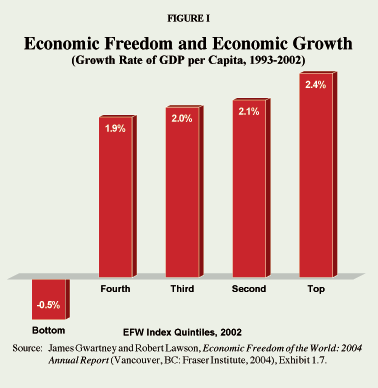
The key ingredients of economic freedom are personal choice, voluntary exchange, freedom to compete, and protection of person and property. Individuals have economic freedom when they acquire, use and trade property without the use of force, fraud or theft. In order to achieve a high economic freedom score, governments must do some things but refrain from others. They must provide sound money and an even-handed legal structure capable of both protecting property rights and enforcing contracts. But they also must keep taxes low and rely primarily on private firms coordinated by markets to determine economic outcomes. Further, they must avoid imposing price controls (in all of their various forms), tariffs, quotas, licensing and other regulations that restrict trade and interfere with individuals’ freedom to contract and compete in product and labor markets.
Since the time of Adam Smith, most economists have argued that free economies will outperform those that are less free. Is this proposition really true? Without a measure of economic freedom, researchers are in a weak position to address this issue objectively. The EFW index provides such a measure. During the last several years, researchers have used the EFW data extensively to analyze various topics. Here we summarize 10 of the major findings of that research.
1. Freer economies grow faster.
Economies that rely on private property, free markets and free trade, and avoid high taxes, regulation and inflation, grow more rapidly than those with less economic freedom.2 For example:
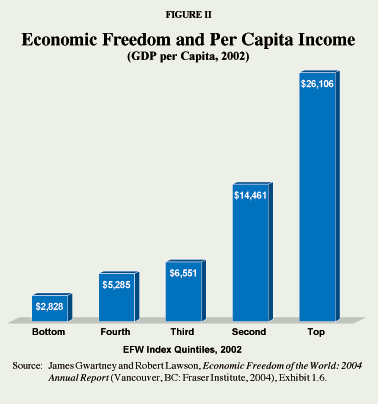
- From 1993 to 2002, the one-fifth of countries with the most economic freedom grew considerably faster than other countries, whereas the one-fifth of countries with the least economic freedom experienced negative growth. [See Figure I.]
- Over the decade, the freest nations averaged annual economic growth of 2.4 percent, while the least free nations contracted by 0.5 percent a year.
Higher growth leads to higher incomes. As shown in Figure II, among the nations in the top fifth of economic freedom, average per capita gross domestic product (GDP) is $26,106 per year compared to $2,828 for the bottom fifth.3
Some case studies illustrate the effect over time of increasing economic freedom in relatively poor countries. [See the sidebar.]
2. Freer economies attract more investment.
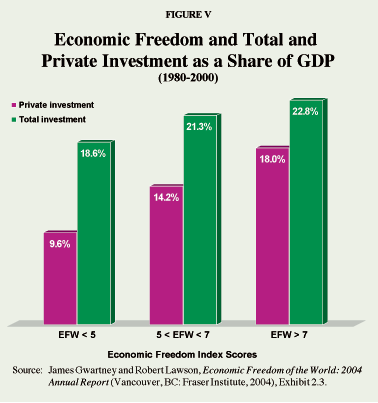 In order to better isolate the impact of economic freedom on investment, the 99 economies with complete data during the 1980 to 2002 period were placed into three categories: those with average ratings of more than 7, ratings of 5 to 7, and ratings less than 5. These economies might be considered mostly free, a middle group, and mostly unfree.
In order to better isolate the impact of economic freedom on investment, the 99 economies with complete data during the 1980 to 2002 period were placed into three categories: those with average ratings of more than 7, ratings of 5 to 7, and ratings less than 5. These economies might be considered mostly free, a middle group, and mostly unfree.
Richer or Poorer: Economic Freedom and Growth in Poor Countries. The least economically free nations tend to be clustered in the Middle East, Latin America, Africa and parts of Asia. Nations in these regions have also experienced below-average economic growth rates, as we would expect. The geographic clustering of these countries has led some economists to conjecture that geographic isolation, topography, abundant natural resources or some other physical attribute determines economic growth. However, Botswana and Mauritius show that some African countries are exceptions to that assumption. Similarly, Hong Kong shows that natural resources are not a requisite for growth.4
Case Study: Botswana & Mauritius versus the rest of sub-Saharan Africa. Botswana, in equatorial Africa, has long had significantly higher levels of economic freedom than other sub-Saharan African nations. As a result, the people of Botswana are generally much better off than the citizens of most other African nations. As Figure III shows, its rate of economic growth has been higher, on average, than any other country in Africa:
- In 1970, Botswana's per capita GDP was $1,072, less than the African average of $1,856.
- After three decades of relatively high economic freedom, Botswana's per capita GDP rose to $7,696 while in the rest of Africa, where economic freedom levels were dismal, per capita GDP rose only slightly to $2,309.
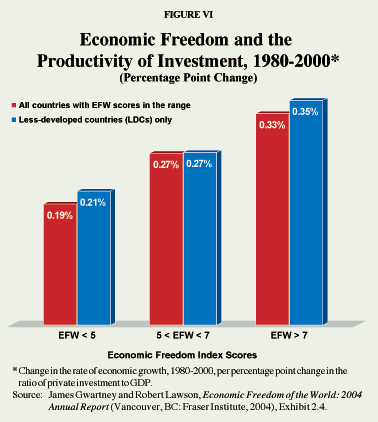
"There is much more private investment."
As Figure V shows, total investment averaged 22.8 percent of GDP in the mostly free economies during the 1980 to 2000 period, compared to only 18.6 percent for the mostly unfree group. However, the difference was even greater for private investment. During the two decades, private investment averaged 18 percent of GDP in countries with EFW ratings of more than 7, but only 14.2 percent for the middle group and 9.6 percent for the least free group. Thus, the private investment rate of the economically free economies was almost twice that of the least economically free group. Foreign direct investment per worker, which is almost entirely private, was an astonishing 45 times greater for the mostly free economies compared to the mostly unfree group. More detailed analysis indicates that this strong positive relation between EFW and investment as a share of GDP continues to hold even after the effects of other factors are taken into account.5
3. Investment is more productive in freer economies.
Economic freedom not only influences the rate of investment, it also influences its productivity. Our research indicates that – holding constant such factors as initial per capita GDP, tropical location, coastal population, change in human capital, and public investment:
- A one percentage point increase in the ratio of private investment to gross domestic product increased the growth of per capita GDP from 1980 to 2000 by 0.33 percentage points in countries with EFW ratings of more than 7. [See Figure VI.]
- But in countries with EFW ratings between 5 and 7, a percentage point increase in the private investment/gross domestic product ratio (I/GDP) enhanced growth by only 0.27 percentage points, and in the least free group growth was enhanced by only 0.19 percentage points.
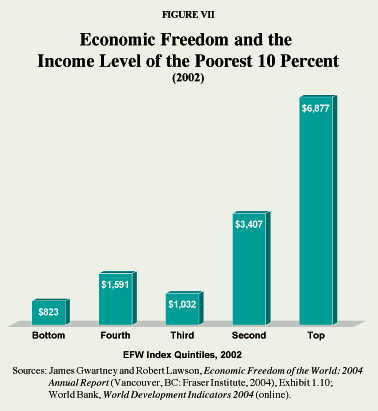
"The poor are better off."
Thus, the productivity of investment – the impact of a unit change of private I/GDP on growth – was more than 70 percent higher in the freer economies than for the group with the least economic freedom.
4. Economic freedom helps reduce poverty.
Anti-globalizers and other opponents of capitalism argue that in liberal economies wealth is concentrated in the hands of a privileged few. Globalization may lead to riches, they say, but the poor are excluded. Yet as it turns out, when a country is economically repressed, its poorest members suffer the most. [See Figure VII.]
In 2002, the average per capita income of the poorest tenth of the population in the least free countries was around $823. By contrast, the poorest tenth of the freest countries' populations earned about $6,877.
5. Income is distributed more equally in freer economies.
Some economists have theorized that as a country's economy grows, income distribution becomes more unbalanced – suggesting a conflict between growth and equality. Researchers traditionally have assumed that equality can only be achieved through growth-reducing taxes and regulations, along with the forcible redistribution of income.
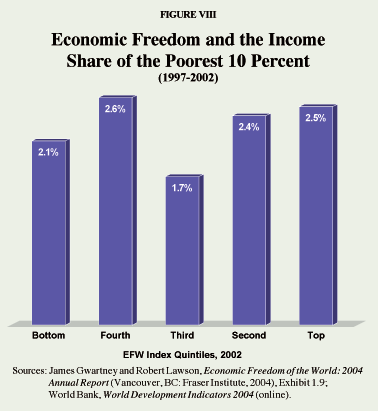 As shown in Figure VIII, the income share of a population's poorest 10 percent is largely unrelated to its degree of economic freedom at a point in time, although in the freest countries the poorest tenth's income share is actually almost 20 percent higher than in the least free countries.
As shown in Figure VIII, the income share of a population's poorest 10 percent is largely unrelated to its degree of economic freedom at a point in time, although in the freest countries the poorest tenth's income share is actually almost 20 percent higher than in the least free countries.
However, economist Niclas Berggren looked at the problem differently by asking: What is the relationship between the change in economic freedom and equality? Berggren compared the EFW Index to recent data on income distribution in 102 countries, finding that the more a country's economic freedom increased between 1975 and 1985, the higher the level of income equality achieved by 1985, with trade liberalization and financial deregulation having the most effect.6
In the short run, some increases in economic freedom – for example, lowering tax rates – increased inequality; but over a 10-year period, increasing economic freedom resulted in a greater degree of equality. While these findings are true for developed, higher-income countries, they are even more significant for low-income, less-developed countries.
"Income is distributed more equally."
This greater equality came primarily through faster growth in the gross incomes of poor people rather than in the incomes of the wealthy. Berggren concludes that to achieve economic growth and equality, a country's economic policies should encourage a steady growth of economic freedom over time.
6. People live longer in economically freer countries.
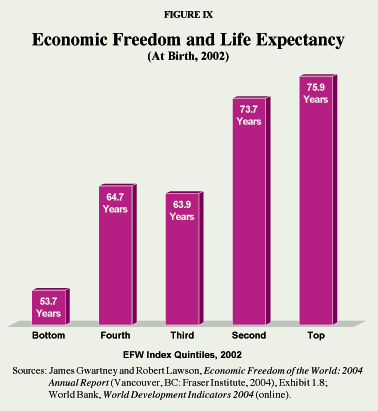
"Child labor has largely disappeared."
In general, economic freedom affects life expectancy. As Figure IX shows:
- Countries that have the highest degree of economic freedom have the highest average life expectancy at birth: almost 76 years.
- Among those countries in the middle, life expectancy is about 64 years.
- Among those countries at the bottom, life expectancy is less than 54 years.
7. Economic freedom improves the lives of children.
Economic freedom has an unquestionable impact on the lives of children. An examination of infant mortality rates (see Figure X) shows:
- Among those born in countries that rank in the bottom fifth in terms of economic freedom, the mortality rate is over 81 per 1,000 live births.
- In sharp contrast, the mortality rate for those born in countries that number in the top fifth is only 9 per 1,000.
Likewise, increased economic freedom is associated with less child labor.
- Among countries near the top of the EFW Index, less than 1 percent of children ages 10 to 14 were in the labor force.
- Conversely, in economically repressed countries, some 21 percent of children ages 10 to 14 were in the labor force.
 8. Economic freedom improves overall human development.
8. Economic freedom improves overall human development.
What defines human development? The United Nations bases its Human Development Index (HDI) on poverty, literacy, education, life expectancy and other factors. The HDI attempts to capture such basic dimensions as: (1) A long and healthy life, as measured by life expectancy at birth; (2) Knowledge, as measured by the adult literacy rate and the proportion of children enrolled in school; (3) A decent standard of living, as measured by GDP per capita, adjusted for difference in the purchasing power of that country's currency.
There is a clear correlation between countries that score high on the UN's Human Development Index and those countries that score well in the EFW Index.7 The more economically free a country, the greater the level of human development enjoyed by its citizens. The top fifth most economically free countries have an average score of 9 out of 10 on the Human Development Index whereas those in the bottom fifth have an average score of about 5. [See Figure XII.]
"Human development in terms of health, education, living standards and other factors is much higher."
Take adult literacy, a component of the HDI. Figure XIII shows that the least free countries had an average adult literacy rate of just 73 percent, compared to 90 percent among the freest countries.
9. There is less corruption in economically free countries.
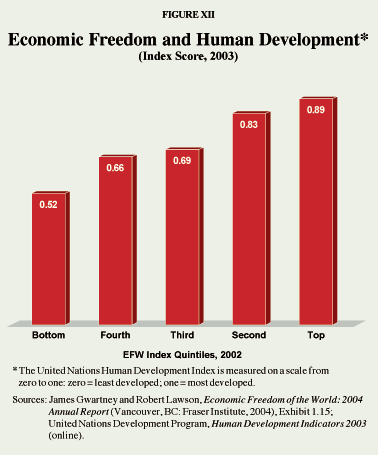 Countries that score poorly on economic freedom are often perceived as corrupt. This should come as no surprise. When faced with high taxes and regulations people will often opt to bribe officials in order to avoid these restrictions on their freedom. [See Figure XIV.]
Countries that score poorly on economic freedom are often perceived as corrupt. This should come as no surprise. When faced with high taxes and regulations people will often opt to bribe officials in order to avoid these restrictions on their freedom. [See Figure XIV.]
10. Economic freedom encourages democracy.
"Economic freedom supports democracy."
The EFW index correlates very highly with measures of political rights and civil liberties. Although there are exceptions, such as Singapore (a country with high economic freedom but low political freedom), the general tendency is for these various aspects of human freedom to go together. [See Figure XV.]
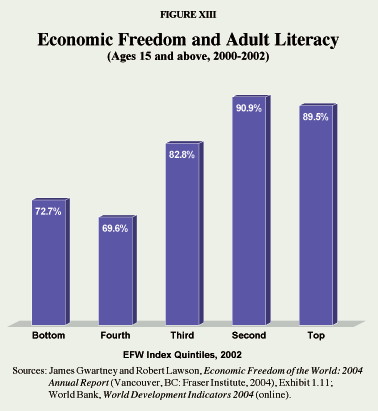
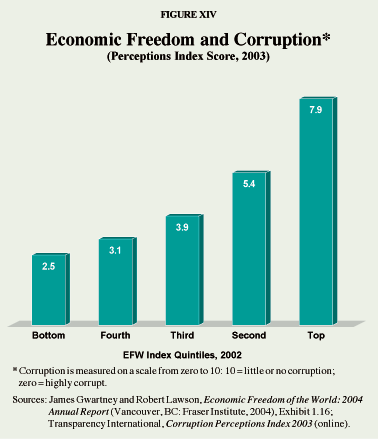
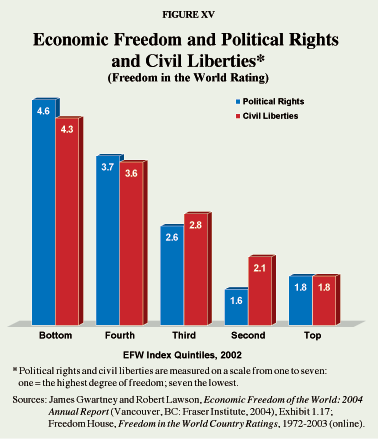
The conclusion is abundantly clear: The freer the economy, the higher the rate of economic growth and the richer the people. Furthermore, economic freedom clearly increases life expectancy, improves the lives of the poor and of children, helps the poor, improves the lives of children, and it supports democracy and many other desirable aspects of healthy societies.
[page]- James Gwartney and Robert Lawson, Economic Freedom of the World: 2004 Annual Report (Vancouver, BC: Fraser Institute, 2004).
- For a complete review, See Niclas Berggren, “The Benefits of Economic Freedom: A Survey,” Independent Review, Vol. 8, No. 2, Fall 2003.
- Unless otherwise indicated, all dollars in this study are U.S. dollars adjusted for purchasing power parity.
- Press Release, “Increasing Economic Freedom Leads to Greater Democracy and Prosperity According to New Report,” July 8, 2003, Fraser Institute.
- See Chapter 2 of James Gwartney and Robert Lawson, Economic Freedom of the World: 2004 Annual Report.
- Niclas Berggren, “Economic Freedom and Equality: Friends or Foes?” Public Choice, Vol. 100, Issue 3, September 1999.
- Seth W. Norton, “Poverty, Property Rights and Human Well-Being: A Cross-National Study,” Cato Journal, Fall 1998, pp. 233-245.
James D. Gwartney is Professor of Economics in the DeVoe Moore Center for the Study of Critical Issues in Economic Policy at Florida State University. He served as Chief Economist of the Joint Economic Committee of the US Congress during 1999/2000. He is the co-author of a leading textbook, Economics: Private and Public Choice, and of What Everyone Should Know about Economics and Prosperity. His professional publications have appeared in the American Economic Review, Journal of Political Economy, Industrial and Labor Relations Review, Cato Journal, and Southern Economic Journal. His doctoral degree in economics is from the University of Washington, and he is a member of the Mont Pelerin Society.
Robert A. Lawson is Professor of Economics and George H. Moor Chair in the School of Management at Capital University in Columbus, Ohio. A Cincinnati native, he earned his B.S. in economics from the Honors Tutorial College at Ohio University and his Ph.D. in economics from Florida State University. Lawson has professional publications in Public Choice, Cato Journal, Journal of Labor Research, Journal of Institutional and Theoretical Economics, and European Journal of Political Economy. He also serves as the director of the Center for Economic Growth and Prosperity for the Ohio-based Buckeye Institute for Public Policy Solutions. Lawson is currently the President of the Association of Private Enterprise Education.
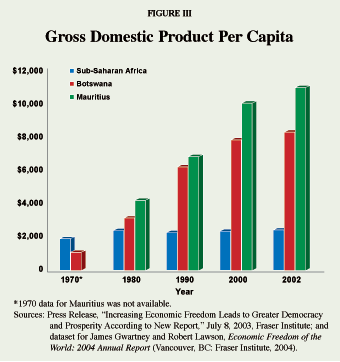 Case Study: Botswana & Mauritius versus the rest of sub-Saharan Africa. Botswana, in equatorial Africa, has long had significantly higher levels of economic freedom than other sub-Saharan African nations. As a result, the people of Botswana are generally much better off than the citizens of most other African nations. As Figure III shows, its rate of economic growth has been higher, on average, than any other country in Africa:
Case Study: Botswana & Mauritius versus the rest of sub-Saharan Africa. Botswana, in equatorial Africa, has long had significantly higher levels of economic freedom than other sub-Saharan African nations. As a result, the people of Botswana are generally much better off than the citizens of most other African nations. As Figure III shows, its rate of economic growth has been higher, on average, than any other country in Africa: 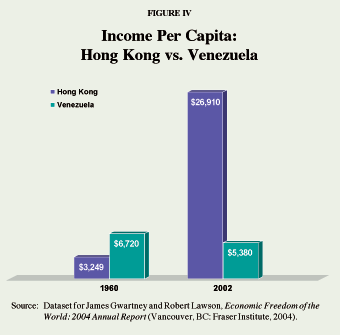 Case Study: Venezuela versus Hong Kong. Why do some countries succeed and others fail? Why do some go from poor to rich while others go from rich to poor? A 1960 to 2002 comparison of Hong Kong (with virtually no natural resources) and Venezuela (with an abundance of oil and other natural resources) illustrates how economic freedom can make a difference. [See Figure IV.]
Case Study: Venezuela versus Hong Kong. Why do some countries succeed and others fail? Why do some go from poor to rich while others go from rich to poor? A 1960 to 2002 comparison of Hong Kong (with virtually no natural resources) and Venezuela (with an abundance of oil and other natural resources) illustrates how economic freedom can make a difference. [See Figure IV.]